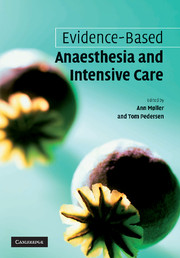Book contents
- Frontmatter
- Contents
- Foreword
- Contributors
- 1 Introducing evidence-based anaesthesia
- 2 How to define the questions
- 3 Developing a search strategy, locating studies and electronic databases
- 4 Retrieving the data
- 5 Critical appraisal and presentation of study details
- 6 Outcomes
- 7 The meta-analysis of a systematic review
- 8 Bias in systematic reviews: considerations when updating your knowledge
- 9 The Cochrane Collaboration and the Cochrane Anaesthesia Review Group
- 10 Integrating clinical practice and evidence: how to learn and teach evidence-based medicine
- 11 Involving patients and consumers in health care and decision-making processes: nothing about us without us
- 12 Evidence-based medicine in the Third World
- 13 Preoperative anaesthesia evaluation
- 14 Regional anaesthesia versus general anaesthesia
- 15 Fluid therapy
- 16 Antiemetics
- 17 Anaesthesia for day-case surgery
- 18 Obstetrical anaesthesia
- 19 Anaesthesia for major abdominal and urological surgery
- 20 Anaesthesia for paediatric surgery
- 21 Anaesthesia for eye, ENT and dental surgery
- 22 Anaesthesia for neurosurgery
- 23 Cardiothoracic anaesthesia and critical care
- 24 Postoperative pain therapy
- 25 Critical care medicine
- 26 Emergency medicine: cardiac arrest management, severe burns, near-drowning and multiple trauma
- Glossary of terms
- Index
7 - The meta-analysis of a systematic review
Published online by Cambridge University Press: 05 September 2009
- Frontmatter
- Contents
- Foreword
- Contributors
- 1 Introducing evidence-based anaesthesia
- 2 How to define the questions
- 3 Developing a search strategy, locating studies and electronic databases
- 4 Retrieving the data
- 5 Critical appraisal and presentation of study details
- 6 Outcomes
- 7 The meta-analysis of a systematic review
- 8 Bias in systematic reviews: considerations when updating your knowledge
- 9 The Cochrane Collaboration and the Cochrane Anaesthesia Review Group
- 10 Integrating clinical practice and evidence: how to learn and teach evidence-based medicine
- 11 Involving patients and consumers in health care and decision-making processes: nothing about us without us
- 12 Evidence-based medicine in the Third World
- 13 Preoperative anaesthesia evaluation
- 14 Regional anaesthesia versus general anaesthesia
- 15 Fluid therapy
- 16 Antiemetics
- 17 Anaesthesia for day-case surgery
- 18 Obstetrical anaesthesia
- 19 Anaesthesia for major abdominal and urological surgery
- 20 Anaesthesia for paediatric surgery
- 21 Anaesthesia for eye, ENT and dental surgery
- 22 Anaesthesia for neurosurgery
- 23 Cardiothoracic anaesthesia and critical care
- 24 Postoperative pain therapy
- 25 Critical care medicine
- 26 Emergency medicine: cardiac arrest management, severe burns, near-drowning and multiple trauma
- Glossary of terms
- Index
Summary
Meta-analysis (MA) uses numerical tools to synthesise effect measures from the data discovered in the literature search of randomised controlled trials (RCTs) for a systematic review (SR). An effect measure is a single number that contrasts the results of two different treatments. Commonly used effect measures for binary data are the risk ratio (RR) or the odds ratio (OR); the one or the other is calculated for each included study. Statistical methods for an MA are straightforward. A summary effect measure for data from all included studies is the desired output of the MA and is displayed in a forest plot. It is critically important to minimise bias in estimating this value. Techniques in MA to identify and/or minimise bias include the funnel plot, the exploration of clinical and statistical heterogeneity and the use of sensitivity analysis.
Introduction
Suppose that an anaesthesiologist reads an SR of most improbable research studies comparing cyclopropane versus diethyl ether general anaesthesia for aortic valve surgery. The conclusion offered is that the cyclopropane is favoured because the summary RR for mortality is 0.6 (95% confidence interval (CI) 0.45 to 0.8) with an I2 statistic of 80%. From whence did these numbers appear? What do they mean?
A fundamental distinction must be drawn between an SR and an MA.
- Type
- Chapter
- Information
- Evidence-based Anaesthesia and Intensive Care , pp. 46 - 60Publisher: Cambridge University PressPrint publication year: 2006



